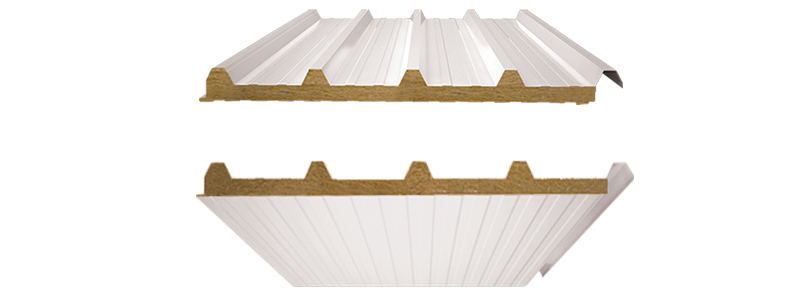3- Production method and machinery
Because rock wool is made up of layered interwoven fibers, it is inherently soft and easily breakable in layers, therefore, the two sheets are arranged in cubes of brick rectangles. This way not only there would be a gap between the joints, but also the parts of the plugs and the tongue or the overlaps won’t have the necessary strength even during the installation stage.
For a long time, we have been looking to eliminate these two major disadvantages of rock wool sandwich panels so that we can enjoy the many advantages of these panels without any worries. In this regard, and to eliminate these two shortcomings, Arya Baron sandwich panels with PIR injection in both edges were launched to the market.
In this type of special panels, polyurethane injected in the two edges, firstly, compresses the rock wool blocks together and eliminates the distance between them, and secondly, in the plugs and tongue part or overlap of insulation and creates high strength between the top and bottom sheets.
In the continuous automatic production line (Continuous), the rock wool sandwich panel first opens the pre-painted sheets on the top and bottom and then each passes through the electric discharge device separately. The electric discharge device prepares the sheet for better adhesion and has a great effect on the quality of rock wool adhesion to the sheet.
The sheets then enter the final pre-heater and heater with a controlled atmosphere to reach the desired temperature for a good adhesive reaction on the sheet. The quality of the adhesive in terms of fire resistance and insolubility in water has a great effect on the final sandwich panel and if it has a poor quality fire-retardant adhesives are used, fire resistance, which is a main feature of this type of panel, will be lost, and water-soluble refractory adhesives will lose their adhesion over time against moisture, and the sheets made of wool would be separated from the rocks. Then the wool of the rocks, which are cut into rectangular cubes, are automatically placed on the sheets and the two sides of the sandwich panel are injected with PIR or (B1 / B2) insulation materials for better strength. Finally, this sandwich panel enters the rotary press machine for baking and after performing the process of chemical reactions, it leaves the rotary press as a finished product.










